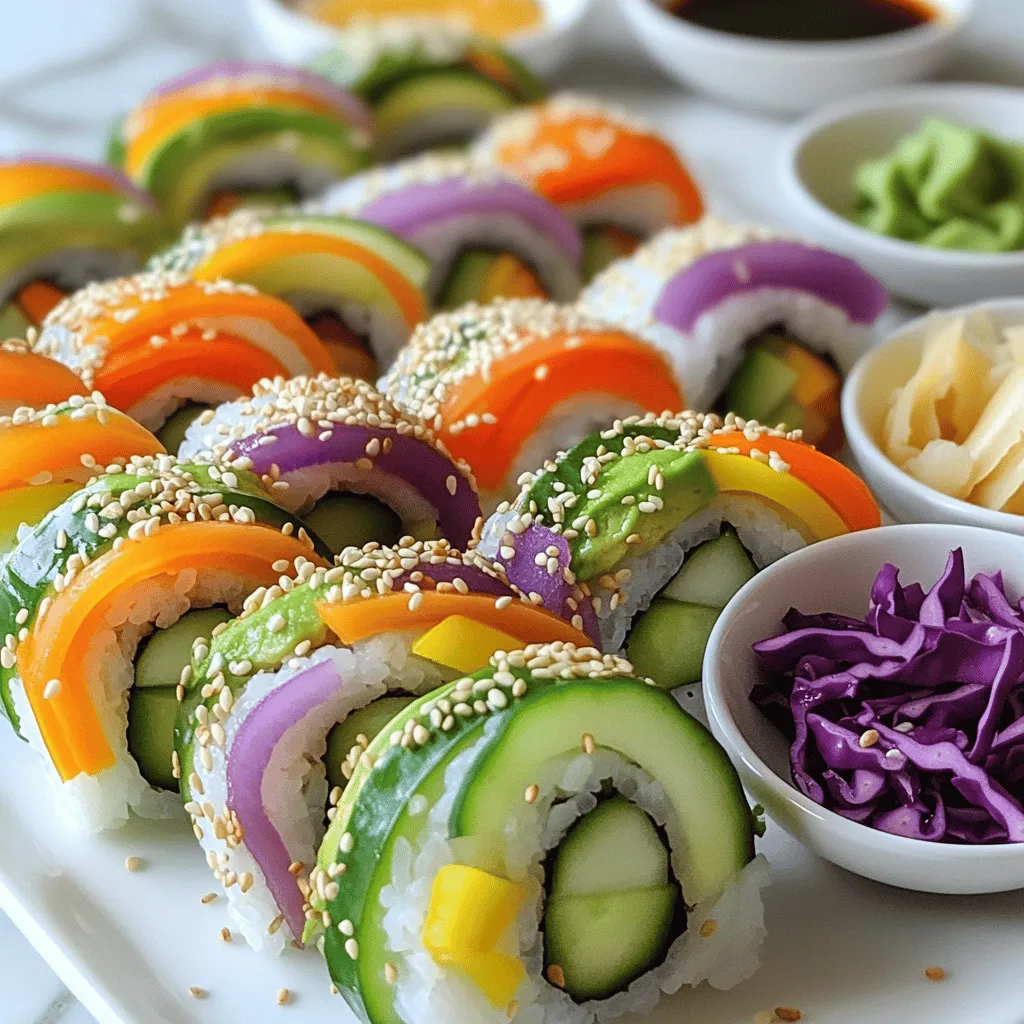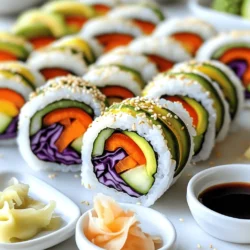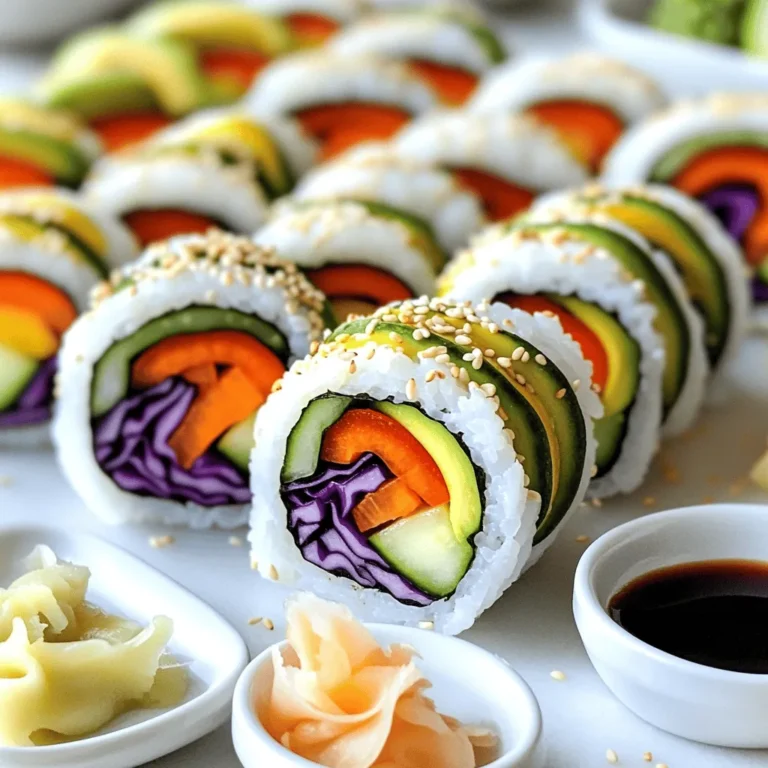Are you ready to dive into the world of delicious vegetarian sushi rolls? In this guide, I’ll share my favorite tips and tricks to help you create fresh and healthy sushi right at home. Not only will we explore essential ingredients and tools, but also popular variations and expert techniques for rolling. Let’s turn your kitchen into a sushi haven and impress your family and friends with your new skills!
Ingredients
Essential Ingredients for Vegetarian Sushi Rolls
To create delicious vegetarian sushi rolls, you’ll need fresh and vibrant ingredients. Here’s a list to get you started:
– 1 cup sushi rice
– 1 ¼ cups water
– 2 tablespoons rice vinegar
– 1 tablespoon sugar
– 1 teaspoon salt
– 4 nori sheets
– ½ cucumber, julienned
– 1 large carrot, julienned
– 1 avocado, sliced
– ½ bell pepper (any color), sliced into thin strips
– ½ cup purple cabbage, thinly sliced
– Sesame seeds (for garnish)
– Soy sauce (for serving)
– Pickled ginger and wasabi (optional, for serving)
Recommended Tools for Making Sushi
Having the right tools makes sushi making easy and fun. Here are some tools you should have:
– Bamboo sushi mat
– Sharp knife
– Rice cooker or saucepan
– Mixing bowl
– Small bowl for the vinegar mixture
Substitutions and Variations for Ingredients
You can be creative with your sushi rolls! Here are some ideas for substitutions:
– Rice: Use brown rice for a healthier option.
– Nori: Try soy paper or lettuce leaves for a different wrap.
– Vegetables: Add bell peppers, zucchini, or even roasted sweet potatoes.
– Garnish: Use crushed nuts or seeds instead of sesame seeds.
Feel free to mix and match according to your taste!
Step-by-Step Instructions
Preparing the Sushi Rice
First, rinse the sushi rice under cold water. Keep rinsing until the water runs clear. This step helps remove excess starch. Next, combine the rinsed rice with 1 ¼ cups of water in your rice cooker or a saucepan. If using a saucepan, bring it to a boil. After boiling, reduce the heat to low, cover it, and simmer for about 20 minutes. The rice should absorb all the water and become tender.
Seasoning the Rice for Flavor
Once the rice is cooked, transfer it to a large bowl. In a small bowl, mix 2 tablespoons of rice vinegar, 1 tablespoon of sugar, and 1 teaspoon of salt. Microwave this mixture for about 30 seconds to dissolve the sugar. Next, gently fold this vinegary mix into the warm rice until it is evenly coated. Let the rice cool to room temperature. This adds flavor and makes the rice sticky.
Assembling and Rolling the Sushi
Now, place your bamboo sushi mat on a flat surface. Lay a sheet of nori, shiny side down, on the mat. Wet your hands with water to prevent the rice from sticking. Take a handful of sushi rice and spread it evenly over the nori. Leave a 1-inch border at the top.
Next, arrange your fillings. Lay julienned cucumber, carrot, avocado, bell pepper, and purple cabbage across the center of the rice-covered nori.
To roll the sushi, start from the bottom edge, closest to you. Carefully roll the sushi tightly away from you. Use gentle pressure and the mat to keep the roll tight. When you reach the top, seal the edge of the nori with a little water.
Finally, use a sharp, wet knife to slice the roll into 6-8 pieces. Wipe the knife with a damp cloth after each cut for cleaner slices. Sprinkle sesame seeds on top for garnish and serve with soy sauce, pickled ginger, and wasabi if you like. Enjoy your colorful and fresh vegetarian sushi rolls!
Tips & Tricks
Best Practices for Rolling Sushi
To roll sushi well, you need some practice. Use a bamboo mat to help. Start with a nori sheet, shiny side down. Spread the rice evenly, but leave a bit of space at the top. Add your veggies in the center. Roll it tight, using the mat. This keeps your roll neat and firm.
How to Keep Sushi Rice Sticky
Sticky rice is key for good sushi. Rinse your sushi rice before cooking. This removes extra starch. Use the right water ratio, usually 1 cup of rice to 1.25 cups of water. Once cooked, mix in rice vinegar, sugar, and salt. Let it cool, but don’t let it dry out.
Presentation Tips for Sushi Rolls
Make your sushi look great on the plate. Slice rolls into equal pieces for a uniform look. Use a sharp knife dipped in water to prevent sticking. Sprinkle sesame seeds on top for a nice touch. You can also add colorful garnishes like sliced radishes or herbs to make it pop.

Variations
Popular Vegetarian Sushi Roll Variations
You can find many vegetarian sushi rolls. Some favorites include the cucumber roll, avocado roll, and sweet potato roll. Each of these rolls offers a unique taste and texture. The cucumber roll is crisp and refreshing. The avocado roll is creamy and rich. Sweet potato adds a hint of sweetness.
Creative Fillings to Try
Think outside the box with your fillings. Here are some fun options:
– Mango: Adds a tropical touch.
– Cream Cheese: Offers a rich flavor.
– Tofu: Provides protein and absorbs flavors well.
– Roasted Red Peppers: Adds a smoky taste.
– Pickled Radish: Gives a tangy crunch.
These fillings can transform your sushi rolls into something special. You can mix and match to find your favorite.
Flavor Combinations for Unique Sushi Rolls
Combining flavors makes sushi exciting. Try these combinations:
– Spicy avocado with sweet mango: A sweet and spicy contrast.
– Tofu with cucumber and sesame: A nutty twist.
– Roasted red pepper, cream cheese, and chives: A savory flavor explosion.
– Mango, avocado, and a hint of lime: Bright and fresh.
Experiment with these ideas to create a roll that sings with flavor.
Nutritional Information
Health Benefits of Vegetarian Sushi
Vegetarian sushi offers many health perks. First, it is rich in vitamins and minerals. Fresh veggies add fiber, which aids digestion. Avocado provides healthy fats that support heart health. Sushi rice gives you a good source of carbs for energy. Plus, nori, the seaweed used, is packed with iodine, which is great for thyroid function. Eating vegetarian sushi can help you feel full without the added calories of meat.
Caloric Breakdown of Ingredients
Here’s a quick look at the calories in the main ingredients:
– Sushi Rice (1 cup): Approximately 200 calories
– Nori Sheet (1 sheet): About 10 calories
– Cucumber (½): Roughly 8 calories
– Carrot (1 large): About 30 calories
– Avocado (1 medium): Around 240 calories
– Bell Pepper (½): About 12 calories
– Purple Cabbage (½ cup): Roughly 12 calories
– Rice Vinegar (2 tbsp): About 6 calories
– Sugar (1 tbsp): Approximately 48 calories
Overall, a serving of vegetarian sushi rolls contains about 300-400 calories, depending on the fillings you choose.
Dietary Considerations for Sushi
Vegetarian sushi is great for many diets. It is gluten-free if you use gluten-free soy sauce. For those watching carbs, you can use cauliflower rice instead of sushi rice. Always check for food allergies, especially with soy sauce and sesame seeds. If you follow a vegan diet, ensure all ingredients are plant-based. This way, you can enjoy a fresh and healthy delight without worry.
FAQs
What is the best rice to use for sushi?
The best rice for sushi is sushi rice. This short-grain rice has a high starch content. This makes it sticky when cooked. Sticky rice holds together well in sushi rolls. You can find sushi rice in most grocery stores. Look for brands labeled as “sushi rice” or “short grain rice.” Always rinse the rice before cooking. This removes excess starch and helps achieve the right texture.
Can I make sushi rolls in advance?
Yes, you can make sushi rolls in advance. However, they are best eaten fresh. If you want to prepare them early, keep them covered in a damp cloth. This helps prevent the nori from getting soggy. Store them in the fridge for up to 4 hours. Just be aware that the texture may change. The nori will lose its crispness. So, for the best experience, make them close to meal time.
What dips or sauces pair well with vegetarian sushi?
Sushi is delicious with a variety of dips and sauces. Soy sauce is the most common choice. It adds a salty flavor that enhances the sushi. You can also try ponzu sauce. This citrus-based sauce brings a bright taste. For a kick, use spicy mayo or sriracha. These add creaminess and heat to each bite. You can also serve your sushi with pickled ginger and wasabi for extra flavor. Enjoy experimenting with different sauces!
Vegetarian sushi is fun and tasty. We covered essential ingredients, tools, and how to create sushi rice. You learned to roll sushi and keep it sticky, with some great tips for presentation. I shared various roll ideas and health benefits, plus answers to common questions.
Now, you can impress friends with delicious, homemade sushi! Enjoy experimenting with new flavors and fillings. Your sushi-making journey is just beginning. Keep trying and have fun!


